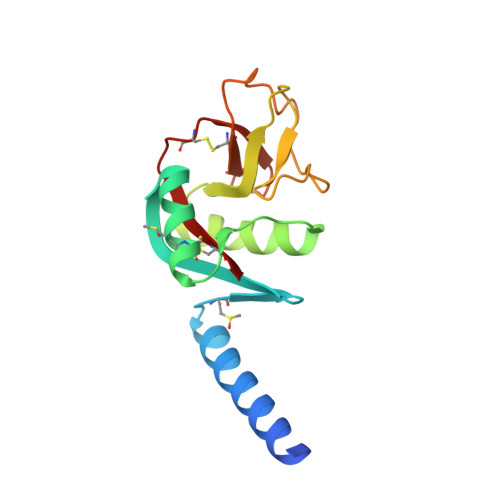Elucidation of Lipid Binding Sites on Lung Surfactant Protein A Using X-ray Crystallography, Mutagenesis, and Molecular Dynamics Simulations.
Goh, B.C., Wu, H., Rynkiewicz, M.J., Schulten, K., Seaton, B.A., McCormack, F.X.(2016) Biochemistry 55: 3692-3701
- PubMed: 27324153
- DOI: https://doi.org/10.1021/acs.biochem.6b00048
- Primary Citation of Related Structures:
5FFR, 5FFS, 5FFT - PubMed Abstract:
Surfactant protein A (SP-A) is a collagenous C-type lectin (collectin) that is critical for pulmonary defense against inhaled microorganisms. Bifunctional avidity of SP-A for pathogen-associated molecular patterns (PAMPs) such as lipid A and for dipalmitoylphosphatidylcholine (DPPC), the major component of surfactant membranes lining the air-liquid interface of the lung, ensures that the protein is poised for first-line interactions with inhaled pathogens. To improve our understanding of the motifs that are required for interactions with microbes and surfactant structures, we explored the role of the tyrosine-rich binding surface on the carbohydrate recognition domain of SP-A in the interaction with DPPC and lipid A using crystallography, site-directed mutagenesis, and molecular dynamics simulations. Critical binding features for DPPC binding include a three-walled tyrosine cage that binds the choline headgroup through cation-π interactions and a positively charged cluster that binds the phosphoryl group. This basic cluster is also critical for binding of lipid A, a bacterial PAMP and target for SP-A. Molecular dynamics simulations further predict that SP-A binds lipid A more tightly than DPPC. These results suggest that the differential binding properties of SP-A favor transfer of the protein from surfactant DPPC to pathogen membranes containing appropriate lipid PAMPs to effect key host defense functions.
Organizational Affiliation:
Beckman Institute and Department of Physics, University of Illinois at Urbana-Champaign , Urbana, Illinois 61801, United States.


















